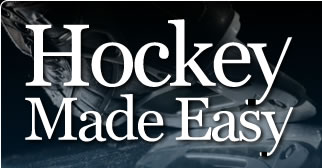Players
starting to play Youth Hockey can practice their
skating skills right at home.
Skating
requires balancing on one leg and this can be
practiced at home.
Understanding your body’s center of gravity and its
tipping point is key.
When this is learned, as
to how far you can bend in one direction without
falling, it will help you stay in an up-right
skating position.
Balancing
Exercises:
You can
practice your skating technique with balancing
exercises at home.
Try standing
on one leg with your shoes on, or in your bare feet.
When you
get really good at balancing on one leg, you can try
it in your skates,
on a
carpeted floor.
Balance
on one leg:
Make sure
your knee is bent or flexed slightly forward; now
try to keep your balance.
Try to
bend slightly at the waist: forward, and
side-to-side without falling.
Discover
your full range of balance; this knowledge will help
both your skating stability
to
remain up right and your bending agility for playing
hockey without falling.
Skating
stance and Shifting your weight:
In your
start skating position your feet should be hip width
to shoulder width apart, both knees flexed forward
all the times so they protrude forward beyond your
toes.
Never
lock your knees or skate straight legged.
Bend at
the waist about 45 degrees with your head leaning
slightly forward.
Now lift one
foot up off the floor about 2 to 4 inches for only a
few seconds, and shift your body weight to your
standing leg, keeping your balance
and
remaining in a semi up-right standing position on
one leg.
Note:
Parents should be close by to prevent your young
child from falling.
Practice
this every few seconds, lift one foot off the floor,
shift your weight fromone
leg to the other, keeping your balance
then shift
to the other leg.
Try this for
a couple of minutes to get the feeling of the rhythm
of skating.
This might
take some practice for younger kids 5 to 6 years old
to keep their balance.
Knees
must remain flexed forward at all times.
That’s all
Skating is, basically shifting your weight from one
leg to your other leg
while taking
short strides or steps at the beginning of the
skating stroke.
You then
increasing them to longer strides or steps as you
start moving forward or backward.
Now practice
pushing outward with the stroke leg skate and glide
forward with your on ice skate
to
develop a smooth “stroke” and “glide” skating
movement.
Skating is
simply a series of stroke and glide on one foot,
stroke and glide foot movements.
These two
movements can be practiced at home in shoes or in
skates.
To Skate
Forward:
Push your
stroking blade's inside edge into the ice, pushing
it outward and backward
like the
letter “C.”
Power
comes from your upper leg, down through your knee,
then calf and anklefinally pushing outward through
the ball of your foot.
Push the
skate outward to its full extension of 180 degrees.
You
should reach your top skating speed after about 4 to
5 skating strokes.
Your
other skate, the glide skate, and the one supporting
your body weight will glide smoothly forward for a
few feet then it becomes the stroking skate.
Remember,
keep your knees bent on both legs at all times.
This
alternating stroke and glide foot movement while
shifting and balancing yourbody weight from one leg
to the other creates forward or backward motion.
The
faster you move your feet, the faster you move
forward or backward.
After you
have conquered the forward skating skills you will
want to start developing your stops, starts,
strides, turns, breakaway speed and
180-degree pivots from forward to backward or
backward to forward.
All of
these skating skills will be required to become a
very good hockey player.
To become
an even better skater or hockey player, I suggest
you go general skating every chance you can, or play
shinny hockey as often as possible on a frozen
river, pond, backyard rink or municipal outdoor rink
to develop your skating & hockey skills.
And
should you fall learning to skate, and most
beginners will, shake it off and get right back up
and start over again. I highly recommended you wear
a hockey helmet and a thick pair of gloves for added
safety when learning to skate on ice.
Some
Community arenas have aluminum learn to skate
devices that you can hold on to.
These
will help you from falling and are designed to keep
you in an upright skating position.
They also
provide enough foot room to allow you to develop
your stroke and glide correctly.
Start
skating from a standing or stopped position:
To begin
skating from a standing or stop position, turn your
skates outward in a
“V”
formation to about a 45-degree angle for each skate.
Make sure
both knees are bent and protrude over your toes.
Bend at
the waist with head leaning forward.
Now push
one skate outward and backward to your legs full
extension like the letter C.
Then it’s
the other skates turn to push outward and backward
using it’s inside edge.
Stroke,
stroke, stroke, stroke using alternating feet as
there is no glide when starting from a stopped or
standing position.
This is
sometimes called a 4 Stroke Start and will get you
moving forward in a hurry.
Most
Coaches consider skating to be the single most
important skill to learn and master
for all
young hockey players wanting to play well or get to
the next level.
Practice
makes perfect and will improve your skating skills I
guarantee it.
Taking
Power Skating classes is another option for learning
to skate but can be expensive.
Best of
luck with your skating development and I’m sure with
practice, it will improve dramatically.
John Shorey
Author - “Hockey Made Easy”
www.HockeyMadeEasy.com





